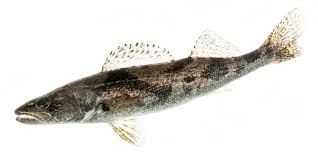Sauger

Species Details
Sander Canadensis
Percidae
Perciformes
Rivers, Lakes, Tributaries, Streams,
1 - 8 lbs.
12" - 21"
Sauger (Sander canadensis) Fish Description
The Sauger is a freshwater fish that is bronze to olive in color with dark color blotches and has a white belly. It has an elongated body and has two dorsal fins; the first dorsal is spined while the second fin is soft-rayed. One of the ways to differentiate it from its closely-resembled relative, the walleye, check its tail if it has a white-tipped. If the white-tipped tail is absent, then it is a sauger.
Saugers are bottom-dwelling fishes that mainly eat insects, small crustaceans, and small fishes.
Interesting Facts About the Sauger
- They have teeth-like formed scales called, ctenoid. Making saugers quite rough to touch.
- The sauger sometimes mates with its close relative, the walleye. The hybrid species is called “saugeye”.
Size
The sauger is small to medium-sized. The biggest Sauger that was ever caught weighed 8 lbs and the longest was 21.8 inches. Their average size is 12-13 inches in length and weighs 1 lb.
Habitat and Distribution
Saugers are light-sensitive and prefer dark muddy waters of rivers, lakes, water reservoirs, and tributaries. They will often hide in crevices or in vegetation to hide and avoid the light and prefer warm water with temperatures of 68-82.4°F. They are a native species that mostly thrive in Missouri, Mississippi, and the Great Lakes. They are highly migratory which helped them to get scattered across the U.S.
They can also be found in Kentucky, Montana, Ohio. In the west, their range is from Wyoming and Oklahoma. In the east, the range is from New York to Alabama. Famous fishing spots for the sauger are located in Lake Sakakawea, Fort Peck, and Cumberland River.
Anglers often catch this game fish during their spawning season, which is March to May. They’re known to lay their eggs in random places and left unattended.
How to Fish for Saugers
As game fish, they are known to be aggressive which the anglers love and they also have good meat. They are known to hide during the day, so it takes real patience to catch one. Check for muddy areas, vegetation, or branches where they are most likely hiding or taking a rest. They are light-sensitive fish, and these specialized eyes are for night feeding, which makes night time or early morning to be the best time to catch saugers. Remember they are bottom-dwelling fish which makes them hard to fly fish, so use jigs that will help you present your bait to their 25-40 feet sweet spot. Try to also look for holes and try to cast your bait to hit the bottom, slowly bring it up to tempt the fish to go out of its hole.
Equipment – to fly fish saugers make sure to use rods 7 to 9 feet with a weight around 6 – 8 with a 3 to 5-ounce bell sinker. You can use an 8-12 lb monofilament or braided line. For hook, you can use sizes from #1, 1/0, 2/0, or even 3/0. The size of the hook will depend on your lure or bait.
For Lures, make sure to use brightly colored jigs, spoons, and bucktails. Recommended baits for the saugers are minnows, crayfish, nightcrawler worms, shiners, shad, and other small panfish.






